In this chapter you will be introduced not only to common forms, but also to lesser-known forms, with the intention that you will experiment with forms while writing your own poetry.
Abecedarian
In this form, the poem works its way through the alphabet, each line beginning with the letterfollowing the first letter of the previous line. There are also Abecedarians which have entire stanzas that begin with one letter, such as Carolyn Forche’s long Abecedarian, “on earth.” There are no restrictions on meter or rhyme. The following example demonstrates the abecedarian form:
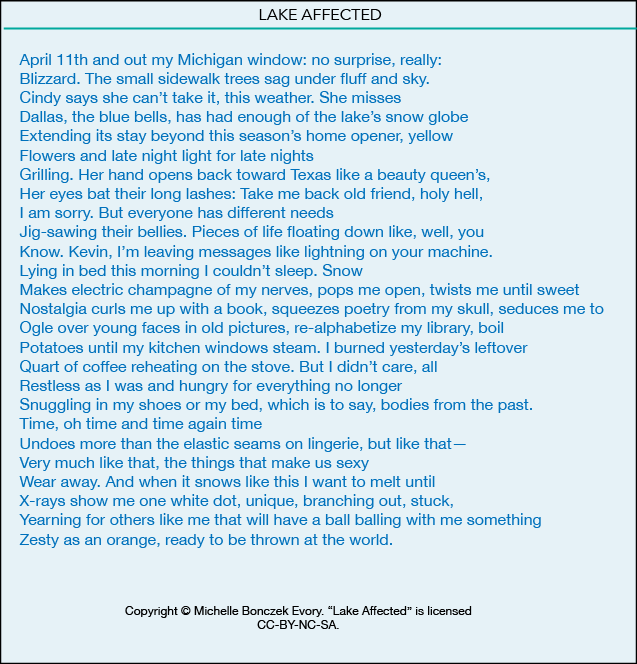
Aubade
Partner to the serenade, which focuses on evening, the aubade is a poem about the morningor dawn. There are no restrictions on line, meter, or rhyme. Here is one by Traci Brimhall:
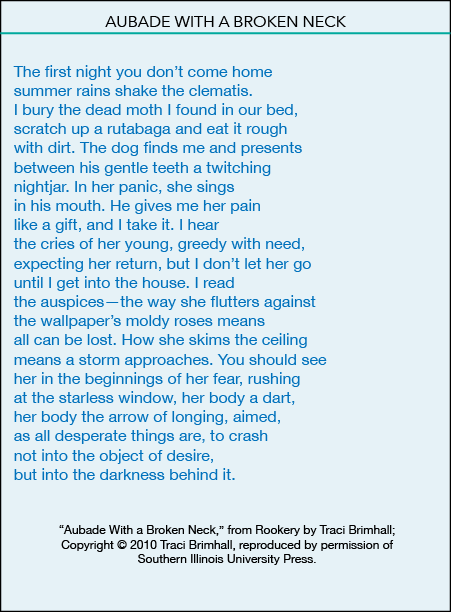
Ballad
Before written language, folk ballads were used around the world to transmit stories—often tragic—from one generation to another. The word “ballad” has its roots in the Latin word ballare, meaning “to dance,” evidence of the rhythmic qualities of the form and its frequent recital to musical accompaniment. Although written in many variations, the ballad is today most commonly written in quatrains and A B C B rhyme. The first and third lines contain eight syllables, while the second and fourth lines contain six. According to Robin Skelton, the most common rhyme scheme is iambic tetrameter alternating with iambic trimeter. The following is a ballad by Muriel Rukeyser:
- Read Ballad of Orange and Grape on PoetryFoundation.org
- Listen to Muriel Rukeyser read the poem here.
Blank Verse
A form that lends itself well to a meditative voice, blank verse is written in iambic pentameter lines that do not rhyme. The Poetry foundation contains numerous examples, including links to those written in 10-syllable lines traditional of epic poems such as John Milton’s Pardise Lost.
Ch’i-Yen-Shih
In this Chinese pattern, each line contains seven monosyllabic words with a caesura after eachfourth word. The rhyme scheme is comprised of the pattern A B C B.
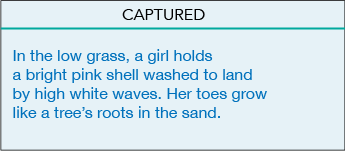
Cinquain
Adelaide Crapsey established this unrhymed iambic form, which consists of a five-line stanza with the syllable count 2 4 6 8 2. Here is an example of one titled “Amaze”and another called “November Night.”
Daina
This Latvian form consists of a quatrain of trochaic octometer lines with feminine endings.Although there are no end rhymes, alliteration and internal rhymes are common. The examplebelow breaks form in the last line and adds a stressed foot for effect.
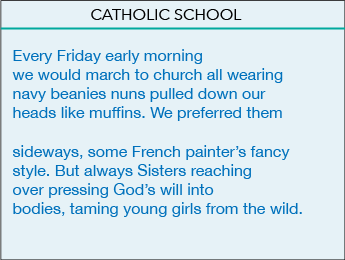
Elegy
An elegy is a lament for the dead and contains the character of sadness and loss. Mark Strandand Eavan Boland explain that an elegy “mourns for a dead person, lists his or her virtues,and seeks consolation beyond the momentary event.” It is considered a public poem thatwhen done best, according Strand and Boland, sets the customs of death in a particular cultureagainst the decorum and private feelings of the speaker.The following is by the poet William Heyen:
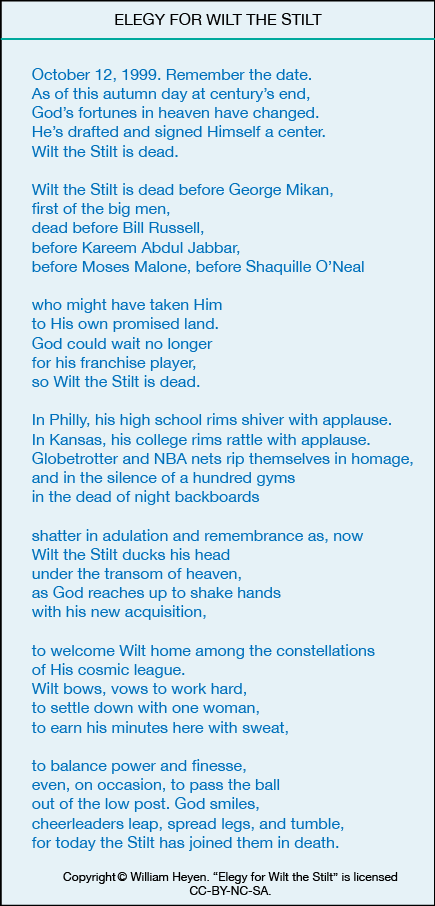
Ekphrasis
Ekphrasis (poetry that describes or responds to visual art) occurs in many forms. Though it is traditionally in response to painting or photography, it can be in response to any kind of art at all (dance, theater, sculpture, music, and on.) New Mexican poet Lauren Camp, in her essay on poetry and art, explains, “The ekphrastic tradition of writing about, or describing, art comes from the early Greeks. The word ekphrasis (or ecphrasis) can be broken down to ek, ‘out,’ and phrasis, ‘speaking.’ Speaking out. Over and over, writers have used art to speak their words… to empower their words.” Here is a poem by Lauren Camp in response to a photograph by Ansel Adams.
Read excerpts of Lauren Camp’s essay here: Excerpts from Lauren Camp Ekphrastic essay
Exquisite Corpse
This form, invented by the Surrealists, is fun to write in a group. Each person writes two lines,then folds the paper so the next person writing can see only the second line; the next personwrites two more lines and folds the paper so that only the second line is visible; and so on.
Ghazal
Typically dealing with subjects of love and separation, the ghazal is a form with Arabic rootsconsisting of rhyming couplets of the same syllabic length and a refrain. As explained on theAcademy of American Poets website:The ghazal is composed of a minimum of five couplets—and typically no more than fifteen—that are structurally, thematically, and emotionally autonomous. Each line of thepoem must be of the same length, though meter is not imposed in English. The first coupletintroduces a scheme, made up of a rhyme followed by a refrain. Subsequent coupletspick up the same scheme in the second line only, repeating the refrain and rhyming thesecond line with both lines of the first stanza. The final couplet usually includes the poet’ssignature, referring to the author in the first or third person, and frequently including the poet’s own name or a derivation of its meaning.
Here is an example of one by Patricia Smith:
Read Hip-Hop Ghazal at PoetryFoundation.org
Haiku
This well-known Japanese form is three lines long and comprised of unrhymed, unmeteredlines with a 5 7 5 syllable count. Traditionally, the haiku’s subject matter relates to nature orseasons.
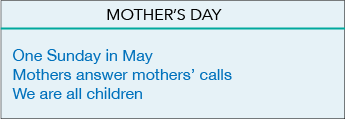
Italian Quatrain
The four lines are written in iambic pentameter and rhyme A B B A.
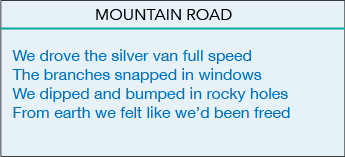
Katauta
In this three-line poem with the syllable count 5 7 7, the first line poses a question that thenext two lines attempt to answer in an intuitive, immediate way. Try answering with the first image that pops into your mind.
What’s in my future?
The budding heads of tulips
Fragrant, red-lipped, and sealed.
Pantoum
Originating in Malaysia, the pantoum was adapted by French poets. It consists of an unlimitednumber of quatrains in which the second and fourth lines of each are repeated in the first andthird lines of the next. The first and third lines of the first stanza become the final stanza’s second and fourth lines. There can be some variation. For instance, the first line of the poem maybe the last.
The following is an example by Melissa Rhoades:
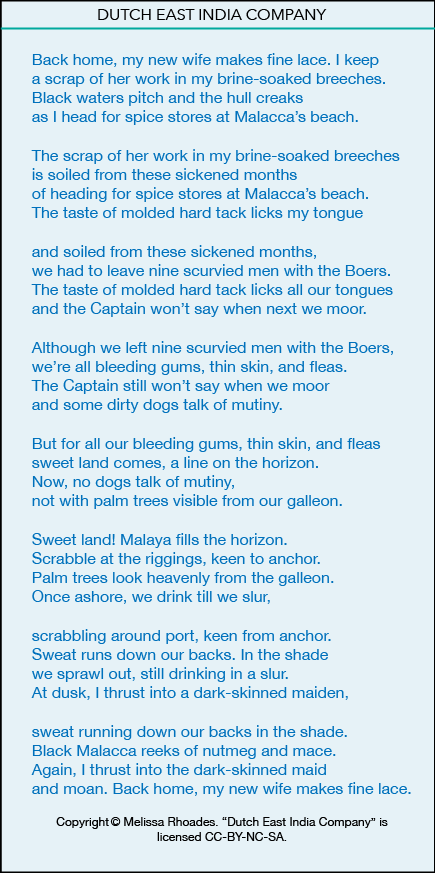
Pregunta
This Spanish form was practiced by poets of the court in pairs during the fourteenth and fifteenth centuries. One poet asks a question or series of questions in one form and the secondpoet, matching the form, answers. The topics usually related to love, philosophy, or morality.
Q: If two loves want one heart
And the heart thrums both loves’ strings
How long before one parts
From two and chooses a single fling?
A: Since no hearts be alike
If no love presumes a thing
You may wish to keep arms wide
And see what each day brings.
Prose Poem
The prose poem, which can be any length, isn’t broken into verse, but contains many of theelements of poetry: figures of speech, musical language, internal rhyme, repetition, condensedsyntax, and imagery. There is some debate over the form, as there are some poets who do notconsider the form a poem, per se, but something more akin to flash fiction, or at least a genreof prose rather than verse. Either way, it is a cross-genre form—half prose, half verse—and funto experiment with.
An influential revivalist of the form was Robert Bly, who said in an 1997 interview that theform is part of an evolution in human democracy: from gods to heroes to everyday humans;from sacred culture to aristocracy to democracy; likewise, from sacred chants in which “allwords are signs” to metered poetry to free verse to prose. Additionally in the interview, Blyspoke about his feeling of freedom and “safety” in writing prose poems: “The most wonderfulthing about the prose poem is that nobody has set up any standards yet.”
The following poem is by Russell Edson, known as “the godfather of the prose poem.” As afather of the form, Edson provided one of the form’s common characteristics: strangeness. Hissubjects tend to be odd, surreal, and humorous. The figure of the ape is one that appears frequently in his poems.
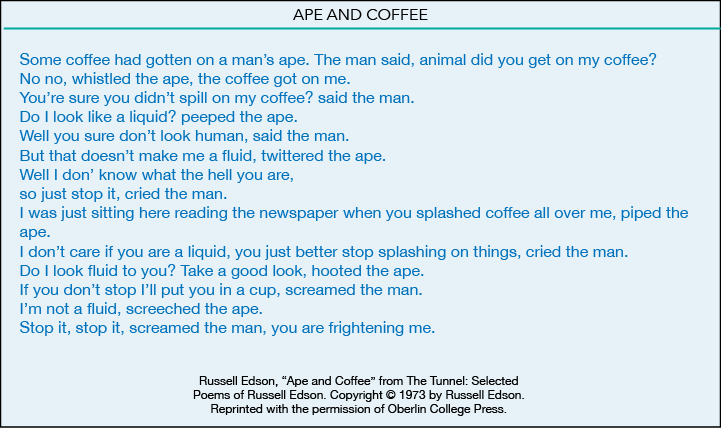
Here is another example by Devon Moore:
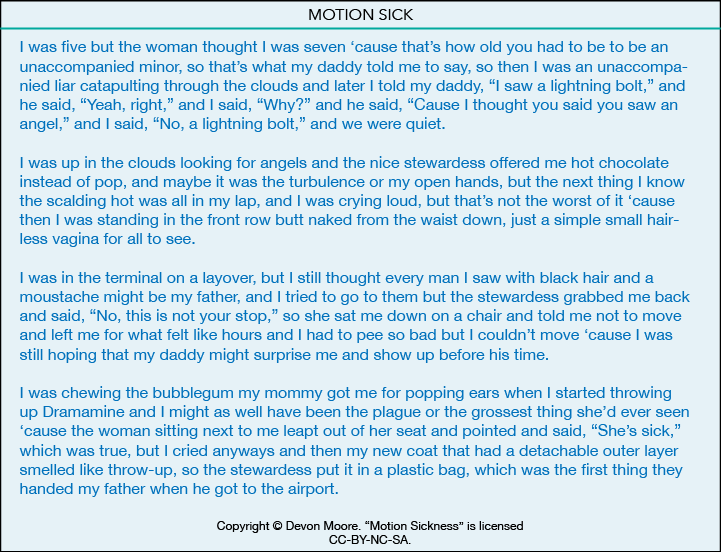
Here is an example of a prose poem by Albuquerque poet Jenn Givhan.
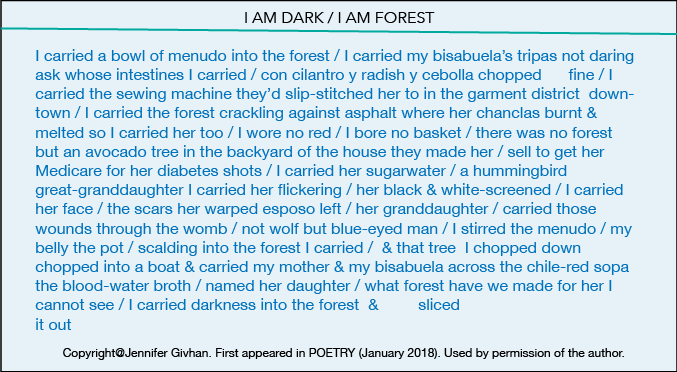
Roundel
The roundel is an English form consisting of eleven lines in three stanzas with no set meter.The first part of line one repeats at the end of the first stanza and again as the last line of poem.The half line also forms the rhyme pattern and is indicated here as R for “refrain”: A B A R–BA B–A B A R.
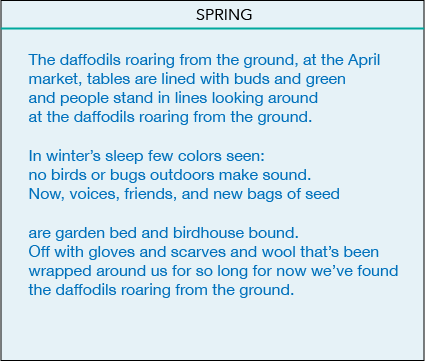
Sestina
The sestina consists of five sestets culminating in a final tercet called an envoi, also called atornada. The six words that end each of the lines in the first stanza repeat throughout thepoem in the following pattern:
- A B C D E F
- F A E B D C
- C F D A B E
- E C B F A D
- D E A C F B
- B D F E C A
- (envoi) E C AorA C E
In addition, the envoi also repeats the words that end lines B D F in the first stanza. Thesethree words can go anywhere in interior of the final tercet’s lines.
Here is an example by Chad Sweeney:
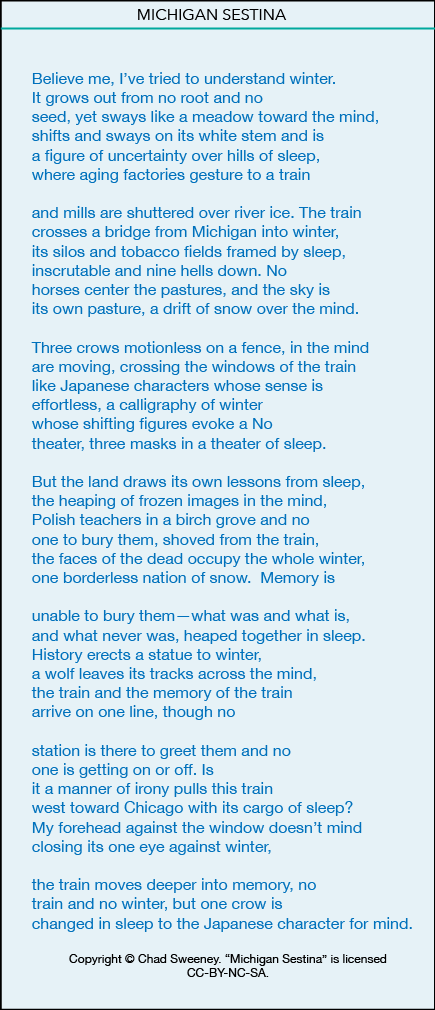
Sonnet
Although there are several versions of the sonnet, each has fourteen lines and contains a volta,or a turn in thought, which can sometimes be indicated with the words “but” or “yet.” In contemporary poetry it has become common for poets to compose sonnets with differing rhymeor meter, or with none at all.
Shakespearian: Comprised of an octet and a sextet, this sonnet is composed in iambicpentameter and rhymes A B A B–C D C D–E F E F–G G. The volta appears eitherbetween lines eight and nine or between lines twelve and thirteen.
Petrarchan: This sonnet contains two stanzas: one octet that rhymes as A B B A–A BB A, and a remaining sextet with varying rhyme schemes. The volta occurs betweenthe stanzas.
Spenserian: This sonnet modifies the Petrarchan to contain a rhyme scheme of A B AB–B C B C–C D C D–E E.
Garrison Keiller featured Billy Collins‘ parody of the form on The Writer’s Almanac.Listen to Billy Collins read it. https://www.poetryarchive.org/poem/sonnet
Split Couplet
Composed of two lines, the split couplet contains a first line in iambic tetrameter and a secondin iambic dimeter; the two lines should rhyme. Another variation is to write the first line iniambic pentameter.
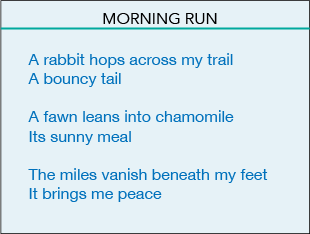
Tanka, or Waka
This Japanese form, which focuses primarily on nature or strong emotions, consists of fiveunrhymed, non-metrical lines with the syllable count 5 7 5 7 7.In Waka, lines one and two, as well as three and four, form complete sentences, as does thelast line.
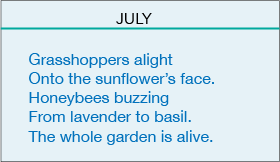
Than-Bauk, or Climbing Rhyme
This Burmese form consists of three four-syllable lines, with rhyme falling on the fourth syllableof the first line, the third syllable of the second line, and the second syllable of the thirdline.
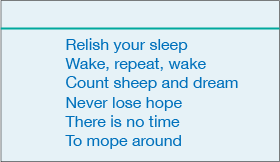
Experiment with different syllable lengths that integrate the same climbing rhyme pattern.
Villanelle
This French form consists of five tercets and a final quatrain. The first stanza’s first and thirdlines repeat in an alternating pattern as the last line in the subsequent stanzas. In the final quatrain,the two lines that have been repeating throughout the poem form the final two lines ofthe poem.
The following villanelle was written by Victor James Daley. It is title is simply “Villanelle”:
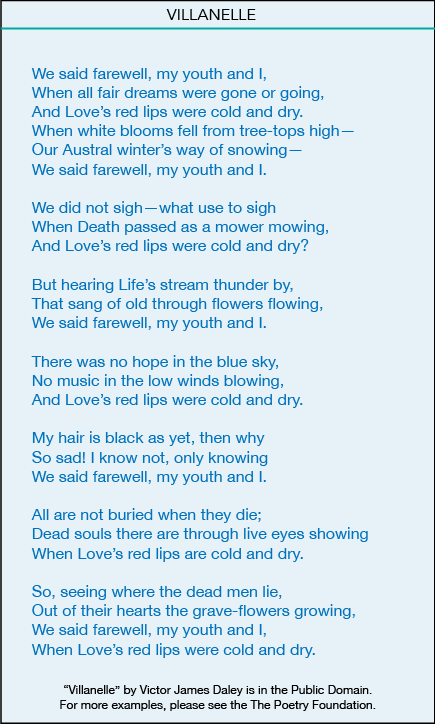
Additional Resources:
The Poet’s Billow. www.thepoetsbillow.org
Adapted from Naming the Unnameable: An Approach to Poetry for New Generations, 2018, by Michelle Bonczek Evory, used according to creative commons CC BY-NC-SA 4.0.